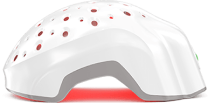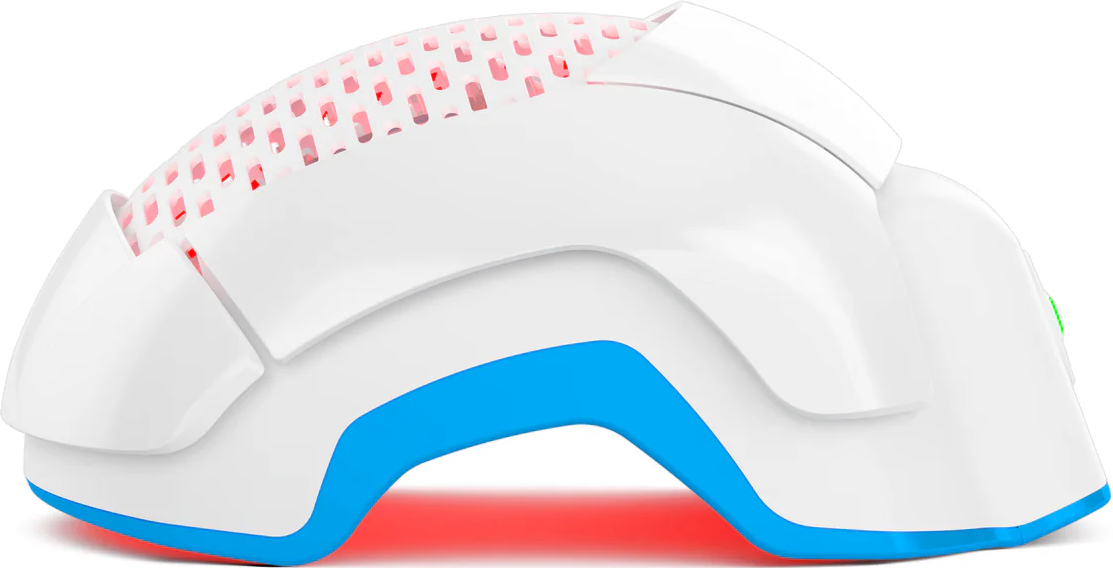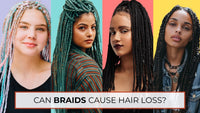Are you worried about losing your precious locks? Losing hair is a common concern that affects both men and women. It causes distress and affects self-esteem. In this quest to find an effective solution to promote hair growth and combat hair loss, laser hair growth caps and helmets have emerged as a remedy. But do laser caps work for hair loss, do they really regrow hair?
Yes, laser caps do work as a hair loss treatment. They utilize low-level laser therapy (LLLT), also known as red light therapy, to stimulate hair follicles and promote hair growth by enhancing blood circulation and cellular activity in the scalp. This process encourages hair follicles to move from the resting phase to the growth phase, resulting in thicker and fuller hair over time.
Numerous clinical studies and user reports have shown that consistent use of laser caps lead to noticeable improvements in hair density, especially for those with mild to moderate hair loss. While individual results vary, laser caps are a safe and non-invasive option for promoting hair growth and managing hair thinning.
In this blog, we've explained how laser hair growth caps and helmets work, along with the science behind it. You'll also get to learn about their functionality, benefits, considerations, and efficacy, offering you a comprehensive understanding of their potential in addressing hair loss concerns.
What Exactly are Laser Hair Growth Caps?
Laser hair growth caps are wearable devices designed to stop hair loss and stimulate hair regrowth. They employ a technology called low-level laser therapy, which involves using red light at a low intensity to stimulate the hair follicles on the scalp. The objective is to enhance blood circulation to the follicles, resulting in thicker and fuller hair. These devices are widely promoted as a treatment for male pattern baldness and an alternative to medications like minoxidil and finasteride.
While the efficacy of laser caps for hair restoration varies from person to person, some individuals have experienced significant hair growth and improvement in hair density. It is a non-invasive method of stimulating hair growth and can be used in combination with other hair loss treatments. However, to achieve the benefits, consistency and adherence to the recommended treatment schedule are important.
There are currently more than twenty manufacturers producing what are commonly known as baseball laser caps on the market. This surge is largely due to an influx of Asian manufacturers that supply these products to U.S. companies, which then rebrand and resell them under their own names. Despite the variety of brands, these laser caps all use the same edge-emitting lasers found in consumer electronics such as DVD and CD players, as well as laser pointers.
Baseball laser caps operate using pulsed lasers rather than continuous-wave light, meaning the devices alternate between ‘on’ and ‘off’ cycles during treatment. As a result, the effective treatment time is cut in half. For example, a 30-minute session actually delivers only about 15 minutes of active laser exposure. Most of these devices provide an energy dosage below 0.1 J/cm², which is insufficient for biostimulation.
Structurally, these products consist of a plastic bowl-like insert containing the laser diodes, over which a cloth baseball cap is placed. This design lacks proper ventilation, causing heat buildup during operation. The additional heat contributes to scalp irritation and in turn actually triggers telogen effluvium, a form of hair shedding. Moreover, the baseball cap design is not optimized for treating either male or female pattern hair loss. Despite this, many vendors promote their devices as stylish enough for public wear, which is unrealistic.
Most baseball laser caps are designed to output 5 mW per diode; however, as internal temperatures rise, the optical output of each diode quickly drops from 5 mW to less than 0.5 mW within seconds. This makes them highly inefficient. In fact, the more diodes included in the cap, the greater the overall reduction in optical performance. Consequently, the real-world (in vivo) laser output is far below what manufacturers claim, especially when compared with FDA-cleared laser caps that maintain stable power and consistent energy delivery.
What’s the Difference Between a Laser Cap and a Laser Helmet?
Although both laser hair caps and laser helmets use LLLT to stimulate hair growth, the two device types differ in a few areas:
1. Coverage
Laser helmets deliver consistent laser energy across the entire scalp, unlike baseball laser caps which experience power loss as internal temperatures rise. Specifically, helmets maintain stable output through better thermal management, and this means that each diode continues operating at its intended power level throughout sessions.
2. Design
Laser helmets have housings that position lasers at an optimal distance and angle from the scalp. This alignment allows for deeper light penetration, something soft fabric caps struggle with. Helmets also feature medical-grade lasers, as opposed to EELs, and undergo testing to meet FDA clearance standards.
3. Comfort
Rather than the enclosed baseball cap design which traps heat, laser helmets incorporate proper ventilation and ergonomic padding. This makes it so that heat buildup and scalp irritation is prevented, while allowing for longer, more comfortable treatment.
4. Durability
Laser helmets are built from durable materials which maintain their shape and alignment over time, ensuring reliable performance even with daily use. Cloth-based caps, on the other hand, can deform and therefore lead to uneven light exposure and decreased effectiveness.
5. Results
Owing to their design and power consistency, laser helmets give a level of performance closer to that of in-clinic laser therapy systems. They’re an ideal choice for those who want measurable, long-term improvement in hair density and thickness without the drawbacks of cheaper, consumer-grade caps.
How Do Laser Caps Work for Hair Loss?
Laser caps use a technology called low-level laser therapy to stimulate hair growth and slow hair loss. These caps contain low-power lasers that emit red light wavelengths, which penetrate the scalp and are absorbed by hair follicles.
The absorbed light energy stimulates cellular activity within the follicles by increasing the production of adenosine triphosphate (ATP), the energy source for cells. This boost in cellular energy promotes hair follicle function, encouraging hair follicles to transition from a resting phase to an active growth phase. Additionally, LLLT improves blood circulation in the scalp by causing vasodilation, which increases the delivery of oxygen and nutrients essential for healthy hair growth.
While laser caps do not affect the hormone DHT (dihydrotestosterone), which is a primary cause of male pattern baldness, they work through a different pathway to enhance follicle health and support hair regrowth. Clinical studies have shown that consistent use of laser caps can lead to increased hair density and thickness, especially in individuals with mild to moderate hair thinning.
Read More: How Laser Works Better for Hair Growth as compared to LED
How Often Should You Use Laser Cap?
The frequency of use for your laser cap depends on the specific model. Some recommend using the laser hair device daily for 6 minutes, while others recommend using it 3-4 times a week, with each session lasting between 15-30 minutes. This level of usage generally refers to the first 3-6 months, after which it can be reduced solely for maintenance.
What Are the Benefits of Laser Hair Growth Caps?
Laser hair caps have worked to improve hair density and overall hair health. Here are some potential benefits associated with using laser caps or helmets for hair loss treatment:

Stimulating Hair Growth: The lasers in the helmet stimulate hair follicles, potentially promoting new hair growth. The low-level lasers shine light on the scalp and aim to energize the hair follicles. This light energy helps wake up follicles that have become weak or dormant.
Reducing Hair Loss: Low-level laser therapy (LLLT) may help in slowing down the process of hair loss.
Convenience: As a wearable device, laser hair caps are convenient and easy to use in the comfort of your home.
Learn more about the benefits of laser caps in our comprehensive blog.
Can You Combine Laser Cap Therapy with Other Hair Loss Treatments?
Yes, laser caps can work with other treatments to treat hair loss, often leading to better results. Light therapy is non-invasive and safe for most people, so it can be added to your current treatment plan. Laser caps use low-level laser technology that provides ongoing stimulation to hair follicles and can be safely used alongside topical treatments like minoxidil or prescription medications such as finasteride. Using laser treatments, medications, special shampoos, supplements, or procedures can give better results.
Meanwhile, the other treatments target hair loss in their unique ways. Together, these combined approaches address thinning hair problems more effectively. They work to slow hair shedding, stimulate follicles, and improve hair growth.
Do Laser Hair Caps Have Side Effects?
Laser hair growth caps are generally considered safe for most people, with very few reported side effects. An evidence-based review published in 2016 evaluated 21 relevant studies on low-level laser therapy (LLLT) devices for hair growth and concluded that those devices are safe and effective for both male and female pattern hair loss.
However, some users might experience mild discomfort or irritation on their scalp, especially when first starting treatment. This can include a slight tingling sensation, warmth, or temporary redness, but these effects usually go away quickly.
In rare cases, people with very sensitive skin might have a mild headache or scalp itchiness. It's important to note that laser caps don't use harmful radiation and are designed to be gentle on your scalp. Still, it's always a good idea to follow the instructions carefully and start with shorter sessions to see how your scalp reacts.
How to Choose the Best LLLT Device for Hair Growth?
Choosing the right laser cap for hair growth can feel overwhelming with so many options available. Here are some key factors to consider when making your decision:
- FDA clearance - choose an FDA-cleared device that has been tested for both safety and efficacy. Those manufactured in the USA adhere to higher regulatory standards than imported alternatives.
- Laser wavelength - the most effective wavelength for stimulating hair follicles is 680 nm. Inexpensive laser caps and LED devices operate below 650nm or even 635nm.
- Energy dosage - look for devices that provide around 6 joules/cm² over a 20-minute session, which is the clinically proven dosage for follicle stimulation. Many caps and combination LED/laser units deliver less than 1 joule/cm², resulting in little to no improvement.
- Beam type - select a device that uses continuous, coherent laser light with a narrow beam width (<8 degrees). Pulsed, non-coherent light, common in cheaper devices, scatters too widely and so reduces the amount of light that actually reaches the follicles.
- Heat management - high-quality LLLT devices have 24-karat gold heat sinks alongside built-in ventilation to maintain stable power output and prevent scalp irritation. Most soft-fabric caps lack such heat management, causing diode overheating and reduced laser efficiency.
- Depth of scalp penetration - a good LLLT device delivers light energy up to 5 mm deep, reaching the base of the hair follicle where growth activity happens. LED or low-power laser caps will penetrate less than 1 mm, offering no benefit.
How Much Do Laser Caps Cost?
Laser hair growth devices can vary in design, cost and quality. Cost can depend on the number of lasers built into the caps or the quality of lasers used. Simple devices with a few hundred laser diodes are often available for around $300, while high-end, high-powered devices can cost more than $3,000.
Hair Growth Results with Laser Caps and Helmets
Laser caps and helmets use low-level laser therapy to stimulate hair growth and reduce hair loss. Users typically see results after consistent use, with improvements like thicker, fuller, and healthier hair. The effectiveness varies from person to person, but many report positive changes within a few months of regular treatments.
What Is The Success Rate of Laser Caps and Helmets?
The success rate of laser hair growth devices like laser caps or helmets varies on the specific product. Studies have shown that a significant percentage of users experience hair growth from these laser therapy devices with success rates of 95% to 98% in terms of hair regrowth.
Similarly, a study conducted on 44 men with androgenetic alopecia (male pattern baldness) reported a 35% increase in hair density after 60 sessions of red light therapy helmet. Also, a clinical trial performed on 40 individuals of both genders with androgenetic alopecia showed similar results. However, note that these results are not uniform and vary from individual studies and products.
Specifically, using a Theradome laser helmet has shown impressive results. In fact, 98% of our customers have expressed satisfaction with their outcomes. The positive reviews of Theradome show effectiveness in helping individuals combat hair loss and improve hair density.

Key Features of Theradome Laser Helmet
Optimal Laser Density: The theradome helmet is equipped with a high density of lasers, ensuring thorough coverage of the entire scalp for effective treatment.
Comfortable Design: The helmet is designed to be lightweight and ergonomic, providing a comfortable fit for extended periods of use.
Ease of Use: The Theradome laser helmet is simple to use. Users can wear it in the comfort of their own homes, making the treatment convenient and hassle-free.
Cordless and Hands-Free: The cordless helmet allows users to move freely during the treatment session without being tethered to a power source.
Clinical Strength Laser: The lasers used in the Theradome helmet provide clinical strength low-level laser therapy to target the hair follicles and stimulate growth effectively.
Every day you wait is a day you could have been regrowing your hair. Don't delay the transformation with Theradome's laser helmet. Start today and watch your locks flourish!
Do Laser Caps Work For Hair Growth: Final Thoughts
Laser hair growth caps and helmets rely on low-level laser therapy that stimulates hair follicles and promotes hair growth. These can vary in price from a few hundred to thousands of dollars for high-end devices with powerful laser diodes. This represents a significant investment for most people.

While a few studies demonstrate the effectiveness of low-level laser therapy, some individuals have found laser hair growth caps and helmets effective treatments for male pattern baldness & female pattern hair loss.
Additionally, these devices can be used in conjunction with other treatment options to enhance efficacy and stimulate hair growth.
There are lots of treatment options for your hair loss problem such as a hair transplant, topical medications, red-light therapy, etc. But at first, consult a licensed haircare expert to explore possible treatments and find the best one for you.
Shop Theradome laser hair growth helmet today and revitalize your precious locks.






















